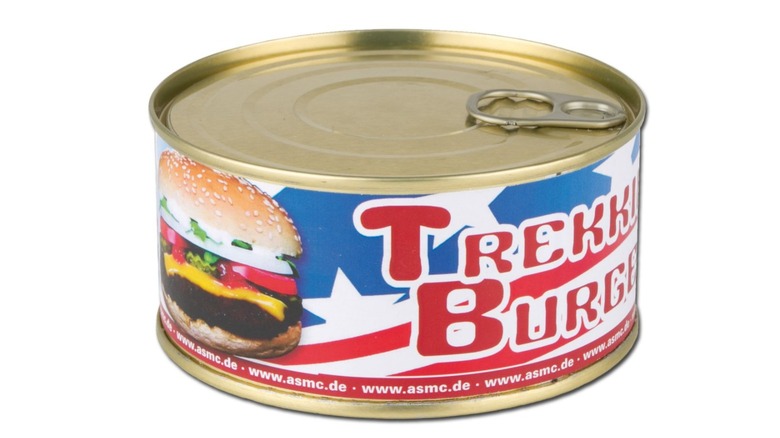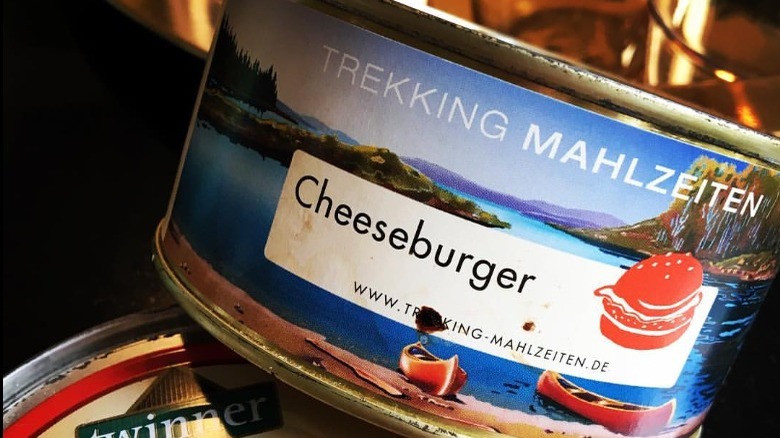Cheeseburger In A Can: You Should Think Twice Before Eating One
Cheeseburgers just might be one of the most portable foods in the world. There's a reason that the burger is the most common staple at fast food chains like McDonald's and Burger King, after all. The cheeseburger in a can was invented in that same spirit, though for a different audience and with drastically different results.
A cheeseburger in a can is exactly what it sounds like. In fact, it might be closer to what it sounds like than you're imagining. It's not like a walking taco that has been disassembled for ease of transport. It's not like the failed McDonald's McDLT, which kept its hot and cold ingredients separate and required assembly. It's an entire assembled cheeseburger — ketchup, mustard, pickles, onions, and beef all on a sesame seed bun — inside of a can.
The cheeseburger was invented in 2008 by the Swiss company Trekking Mahlzeiten as an easy-to-pack meal for hikers. The instructions inform you to boil the can for ten minutes to heat the burger, though it can also be fried in a pan or supposedly be safely eaten without any cooking required. It quickly became a hit with early reaction video creators and was even sampled by the folks over at The Takeout. Judging by their reactions, this is one camping food hack that is best avoided.
What does a cheeseburger in a can taste like?
There probably aren't a lot of people out there who would be surprised to find out that a canned cheeseburger doesn't taste all that great. Registered dietitian Jack Baron told Mel Magazine that the burger didn't look like a real burger but rather a rendering of what one might imagine a cheeseburger would look like. He added that the bun was fairly soggy (likely from the bain-marie preparation) and the patty was somewhere between a solid and a liquid rather than a tender, but chewy, beef patty.
The Takeout had a similar reaction to the burger and described it as something more akin to an overly gray veggie burger than anything made with beef. Some of the tasters described the cheeseburger as "the hamburgers you get in elementary school," a "meat-like puck," and a "dog-food patty." The condiments used on the burger don't seem to add much to the experience either and were mostly overlooked due to the oddity of the patty and buns.
If these loving testimonies haven't dissuaded you from finding one to try yourself, the Trekking Burgers are still available online through German brand The Adventure Company; though they are currently out of stock. It's likely this isn't due to high demand either.
Is a cheeseburger in a can actually safe to eat?
While a cheeseburger in a can may taste the way you expect a cheeseburger in a can to taste, the bigger question is whether this product is safe to be consumed and can be depended on as a shelf-stable option. Canned bread already exists and anyone who's ever had Spam knows that canned meats are a thing, but is it safe to put them together with condiments and expect everything to stay sanitary?
One concerning fact: The cheeseburger is only recommended for consumption within 12 months. That might be a long lifespan for a burger, but it's nothing in canned food years. The USDA claims that most canned foods are good indefinitely when properly prepared and are typically safe for years after their manufacture.
For the most part, canned meats are made safe for consumption by means of sterilization that kills any harmful bacteria inside the cans. None of the reports on the cheeseburger in a can detailed whether or not its meat goes through this sterilization process or how that could be affected by adding the other ingredients. Another concern is the roll it's being served on. Bread is considered a low-acidity food and so it needs special additives or treatment to be considered safe for long-term preservation in this manner.
There's nothing definite that makes this novel approach to an American classic unsafe, but that doesn't mean that it shouldn't be met with some skepticism by would-be diners.


